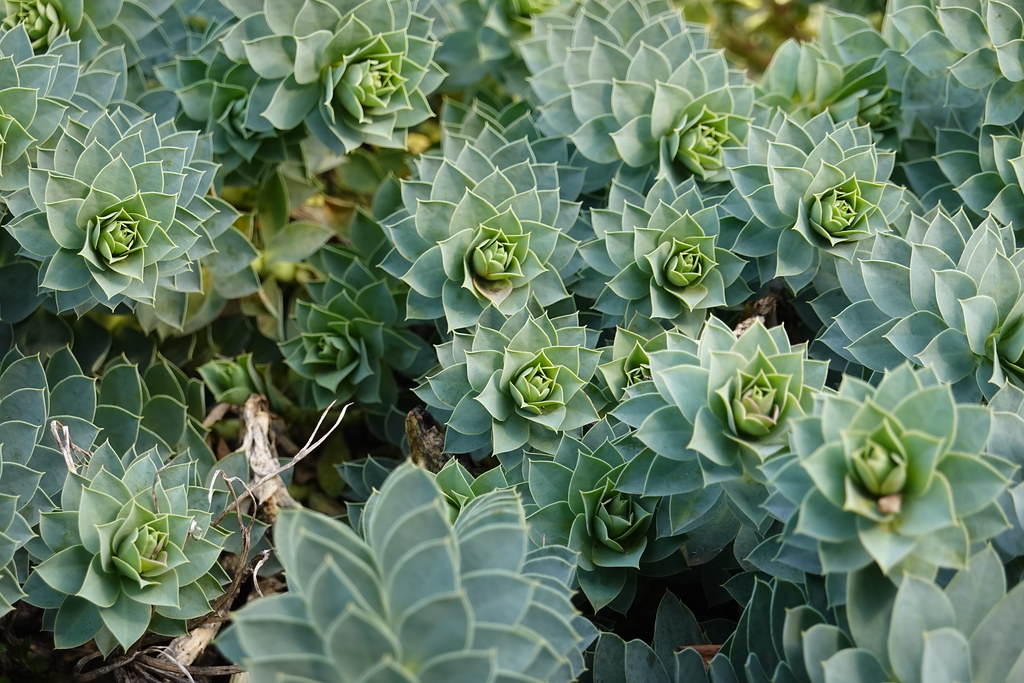Euphorbia myrsinites
Description
- Escaped evergreen garden perennial that grows 10-15 cm tall
- Form low, spreading mounds
- Stems and leaves are blue-green in color
- Leaves are sharp, succulent, alternate, and spiral around the stem
- Inconspicuous flowers are surrounded by small, yellowish flower-like bracts
- Each flower produces a bluish-green seed pod containing three brown seeds
- All parts of the plant contain a toxic, milky white sap
- Prefers full sun and dry, well drained, disturbed soils
Introduction and spread
- Native to southern Europe, central Asia, and the Mediterranean
- Likely introduced to North America as a garden ornamental
- Drought tolerant, so it is popular in rock gardens
- Becomes highly invasive when it escapes cultivation
- Spreads mainly by seed, but also produces new plants through root fragments
- Seeds are released in bursts, dispersing up to ~5 m away
- Seeds can remain viable in soils for up to 8 years
Consequences of invasion
- Invades open areas (e.g., fields, rangelands, gardens) and disturbed areas (e.g., roadsides, waste places)
- Grows rapidly and aggressively
- Releases chemicals that inhibits the growth of native plants
- Reduces forage for wildlife
- Toxic to humans, wildlife, and livestock when consumed
- Toxic sap can cause blindness and skin irritation such as redness, swelling, and blisters
Status in the CKISS region
- Myrtle spurge is currently classified as Eradicate on the CKISS Annual Priority List.
- Myrtle spurge occurs in the CKISS region at a very limited distribution, so eradication is the goal and is considered feasible.
- Please report sightings of this species immediately.
- To learn more about how CKISS classifies and manages invasive species, see our Invasive Species Priority Lists page.
Integrated pest management options
Prevention
- Do not plant this species. Learn about Grow Me Instead and PlantWise to grow non-invasive alternatives instead.
- Maintain crops and natural areas to support a competitive, non-invasive plant community.
- Immediately revegetate bare, disturbed soils with a non-invasive seed mix to reduce invasion.
- Do not move contaminated soils to a new area.
- Clean your clothing, boots, and gear from soils and plant materials before entering/leaving an area.
Mechanical control
- Wear protective clothing and eyewear when handling this species.
- Hand-pull or dig small patches before seed set, removing as much of the roots as possible. Requires repeated treatments, usually over multiple years.
- Mowing can be effective before seed set, but requires repeated treatments.
- Bag and dispose of plant materials properly at a landfill for burial.
Chemical control
- Certain herbicides have demonstrated effective control. Contact professional contractors for guidance.
Cultural control
- Grazing large infestations using sheep/goats can reduce seed production.
- Prescribed burns and composting are NOT recommended.
Biological control
- There are currently no known biocontrol agents for this species in B.C.
Additional resources
- Myrtle spurge | Invasive Species Council of BC
- Myrtle spurge | Okanagan Invasive Species Online
- Myrtle spurge | Midwest Invasive Species Information Network
- Myrtle spurge| Washington State Noxious Weed Control Board














